Toward a Sustainable Livestock Sector in China: Evolution Characteristics and Driving Factors of Carbon Emissions from a Life Cycle Perspective
Abstract
1. Introduction
2. Materials and Methods
2.1. Life Cycle Assessment (LCA)
2.1.1. Feed Grain Consumption System
2.1.2. Energy Consumption System
2.1.3. Enteric Fermentation and Manure Management System
2.1.4. Total Carbon Emissions
2.2. Generalized Divisia Index Method (GDIM)
3. Results
3.1. Livestock Sector Carbon Emission Measurement Results
3.1.1. Evolutionary Trends in Total Carbon Emissions from Livestock Sector
3.1.2. Spatial Characteristics of Livestock Sector Carbon Emissions
3.1.3. Comparative Analysis of Carbon Emissions from Different System Boundaries
3.1.4. Comparative Analysis from Different Livestock Species
3.2. Factor Decomposition of Livestock Sector Carbon Emissions
4. Discussion
5. Conclusions
Author Contributions
Funding
Institutional Review Board Statement
Informed Consent Statement
Data Availability Statement
Acknowledgments
Conflicts of Interest
Abbreviations
| GHG | Greenhouse Gas |
| LAC | Life Cycle Assessment |
| LMDI | Logarithmic Mean Divisia Index |
| GDIM | Generalized Divisia Index Method |
References
- UNEP. Growing greenhouse gas emissions due to meat production. Environ. Dev. 2013, 5, 156–163. [Google Scholar] [CrossRef]
- FAO. Pathways Towards Lower Emissions—A Global Assessment of the Greenhouse Gas Emissions and Mitigation Options from Livestock Agrifood Systems; FAO: Rome, Italy, 2023. [Google Scholar]
- Hu, X.; Wang, J. Estimation of livestock greenhouse gases discharge in China. Trans. Chin. Soc. Agric. Eng. 2010, 26, 247–252. [Google Scholar] [CrossRef]
- Wu, Q.; Zhang, Y.; Zhang, M. Quantitative assessment, temporal and spatial characteristics and dynamic evolution of China’s animal husbandry carbon emissions. J. Arid Land Resour. Environ. 2022, 36, 65–71. [Google Scholar] [CrossRef]
- Bai, X.; Hu, H.; Zhou, Y.; Zhang, Y. Study on space-time evolution and influence factors of carbon emissions in China’s animal husbandry. J. China Agric. Univ. 2023, 28, 260–274. [Google Scholar] [CrossRef]
- Ning, J.; Zhang, C.; Hu, M.; Sun, T. Accounting for Greenhouse Gas Emissions in the Agricultural System of China Based on the Life Cycle Assessment Method. Sustainability 2024, 16, 2594. [Google Scholar] [CrossRef]
- Meng, X.; Cheng, G.; Zhang, J.; Wang, Y.; Zhou, H. Analyze on the spatial temporal characteristics of GHG estimation of livestock’s by life cycle assessment in China. China Environ. Sci. 2014, 34, 2167–2176. [Google Scholar]
- Yao, C.; Qian, S.; Li, Z.; Liang, L. Provincial animal husbandry carbon emissions in China and temporal-spatial evolution mechanism. Resour. Sci. 2017, 39, 698–712. [Google Scholar] [CrossRef]
- Dai, X.; Li, J.; He, Y.; Wang, F. Regional equity and efficiency of carbon emissions of China’s livestock industry in 2000–2020. Resour. Sci. 2023, 45, 62–76. [Google Scholar] [CrossRef]
- Li, Z.; Wei, Q.; Liu, X.; Zhu, R.; Li, C.; Li, Z. The Emission Characteristics of Greenhouse Gases from Animal Husbandry in Shandong Province Based on Life Cycle Assessment. Sustainability 2024, 16, 1375. [Google Scholar] [CrossRef]
- Liang, Y.; Wang, M. Deconstructing the Experience of China’s Pig Industry Carbon Emissions and Choosing a Dynamic Path to Peak. Issu. Agric. Econ. 2023, 10, 101–115. [Google Scholar] [CrossRef]
- Chen, Y.; Shang, J. Estimation and Effecting Factor Decomposition of Green House Gas Emission of Animal Husbandry Industry in Four Pastoral Areas. China Popul. Resour. Environ. 2014, 24, 89–95. [Google Scholar] [CrossRef]
- Chen, S.; Hu, H. Study on the spatial-temporal changes and influence factors of greenhouse gases emission from livestock and poultry in China. China Popul. Resour. Environ. 2016, 26, 93–100. [Google Scholar] [CrossRef]
- Yao, C.; Qian, S.; Mao, Y.; Li, Z. Decomposition of impacting factors of animal husbandry carbon emissions change and its spatial differences in China. Trans. Chin. Soc. Agric. Eng. 2017, 33, 10–19. [Google Scholar] [CrossRef]
- He, D.; Deng, X.; Wang, X.; Zhang, F. Livestock greenhouse gas emission and mitigation potential in China. J. Environ. Manag. 2023, 348, 119494. [Google Scholar] [CrossRef] [PubMed]
- Yan, Q.; Yin, J. Factor Decomposition of Carbon Emissions in Beijing, Tianjin, Hebei: A Study Based on Generalized Divisia Index Method. Sci. Technol. Manage. Res. 2017, 37, 239–245. [Google Scholar] [CrossRef]
- Shao, S.; Zhang, X.; Zhao, X. Empirical Decomposition and Peaking Pathway of Carbon Dioxide Emissions of China’s Manufacturing Sector—Generalized Divisia Index Method and Dynamic Scenario Analysis. China Ind. Econ. 2017, 3, 44–63. [Google Scholar] [CrossRef]
- Wang, S.; Xu, Y.; Weng, D.; Zhang, H.; Wen, X.; Hu, X.; Zhang, L. Driving factors and peak analysis of road traffic carbon emissions in China. Acta Ecol. Sin. 2025, 45, 1315–1327. [Google Scholar] [CrossRef]
- Vaninsky, A. Factorial decomposition of CO2 emissions: A generalized Divisia index approach. Energy Econ. 2014, 45, 389–400. [Google Scholar] [CrossRef]
- Liu, G.; Müller, D.B. Addressing sustainability in the aluminum industry: A critical review of life cycle assessments. J. Clean. Prod. 2012, 35, 108–117. [Google Scholar] [CrossRef]
- Hörtenhuber, S.J.; Seiringer, M.; Theurl, M.C.; Größbacher, V.; Piringer, G.; Kral, I.; Zollitsch, W.J. Implementing an appropriate metric for the assessment of greenhouse gas emissions from livestock production: A national case study. Animal 2022, 16, 100638. [Google Scholar] [CrossRef]
- Ma, Y.; Cao, D.; Luo, W.; Li, G.; Zhang, W.; Li, Y. Carbon Emission Accounting Methodology of Livestock and Poultry Breeding Industry in China Based on Life Cycle Theory. China Environ. Sci. 2024, 44, 2799–2810. [Google Scholar] [CrossRef]
- Xie, H.; Chen, X.; Yang, M.; Zhao, Q.; Zhao, M. The ecological footprint analysis of 1 kg livestock product of China. Acta Ecol. Sin. 2009, 29, 3264–3270. [Google Scholar]
- NCSC. Emission Factor of China’s Regional Power Grid Baseline for the 2021 Emission Reduction Project. Available online: https://ccer.cets.org.cn/notice/noticeDetail?bulletinInfoId=1175122354980917248 (accessed on 8 April 2025).
- IPCC. IPCC Sixth Assessment Report, Climate Change 2022; IPCC: Geneva, Switzerland, 2022.
- Yang, C.; Zhu, Z.; Liu, Z. Analysis on Total Factor Productivity of Regional Animal Husbandry in China. Stat. Decis. 2019, 35, 91–94. [Google Scholar] [CrossRef]
- Guan, D.; Hubacek, K.; Weber, C.L.; Peters, G.P.; Reiner, D.M. The drivers of Chinese CO2 emissions from 1980 to 2030. Glob. Environ. Chang. 2008, 18, 626–634. [Google Scholar] [CrossRef]
- Minx, J.C.; Baiocchi, G.; Peters, G.P.; Weber, C.L.; Guan, D.; Hubacek, K. A “carbonizing dragon”: China’s fast growing CO2 emissions revisited. Environ. Sci. Technol. 2011, 45, 9144–9153. [Google Scholar] [CrossRef] [PubMed]
- Garnier, J.; Noë, J.L.; Marescaux, A.; Sanz-Cobena, A.; Lassaletta, L.; Silvestre, M.; Thieu, V.; Billen, G. Long-term changes in greenhouse gas emissions from French agriculture and livestock (1852–2014): From traditional agriculture to conventional intensive systems. Sci. Total Environ. 2019, 660, 1486–1501. [Google Scholar] [CrossRef] [PubMed]
- Chen, Q.; Zhang, Y. Evolution of carbon reduction policies for animal husbandry—An analysis based on 452 policies. J. Huazhong Agric. Univ. (Soc. Sci. Ed.) 2022, 1, 10–23. [Google Scholar] [CrossRef]
- Li, T.; Wang, M. Research on the Realization Path of Carbon Peaking and Carbon Neutrality Goals Assisted by Animal Husbandry—Based on the Experience Comparison and Enlightenment of Different Countries. World Agric. 2023, 1, 5–16. [Google Scholar] [CrossRef]
- Kumari, S.; Fagodiya, R.K.; Hiloidhari, M.; Dahiya, R.P.; Kumar, A. Methane production and estimation from livestock husbandry: A mechanistic understanding and emerging mitigation options. Sci. Total Environ. 2020, 709, 136135. [Google Scholar] [CrossRef]
- Liu, C.; Ma, G.; Liu, C.; Wang, J.; Xin, X. Review and countermeasures on resource utilization of livestock and poultry manure—Based on the two-dimensional perspective of supply and demand. Heilongjiang Anim. Sci. Vet. Med. 2022, 2, 13–17+25. [Google Scholar] [CrossRef]
- Xin, X.; Wang, X.; Wang, J. High-quality Development of Broiler Industry: Challenges, Trend and Policy. China Poult. 2024, 46, 1–10. [Google Scholar] [CrossRef]
- Hu, C.; Wei, Y.; Hu, W. Research on the Relationship between Agricultural Policy, Technological Innovation and Agricultural Carbon Emissions. Issues Agric. Econ. 2018, 9, 66–75. [Google Scholar] [CrossRef]
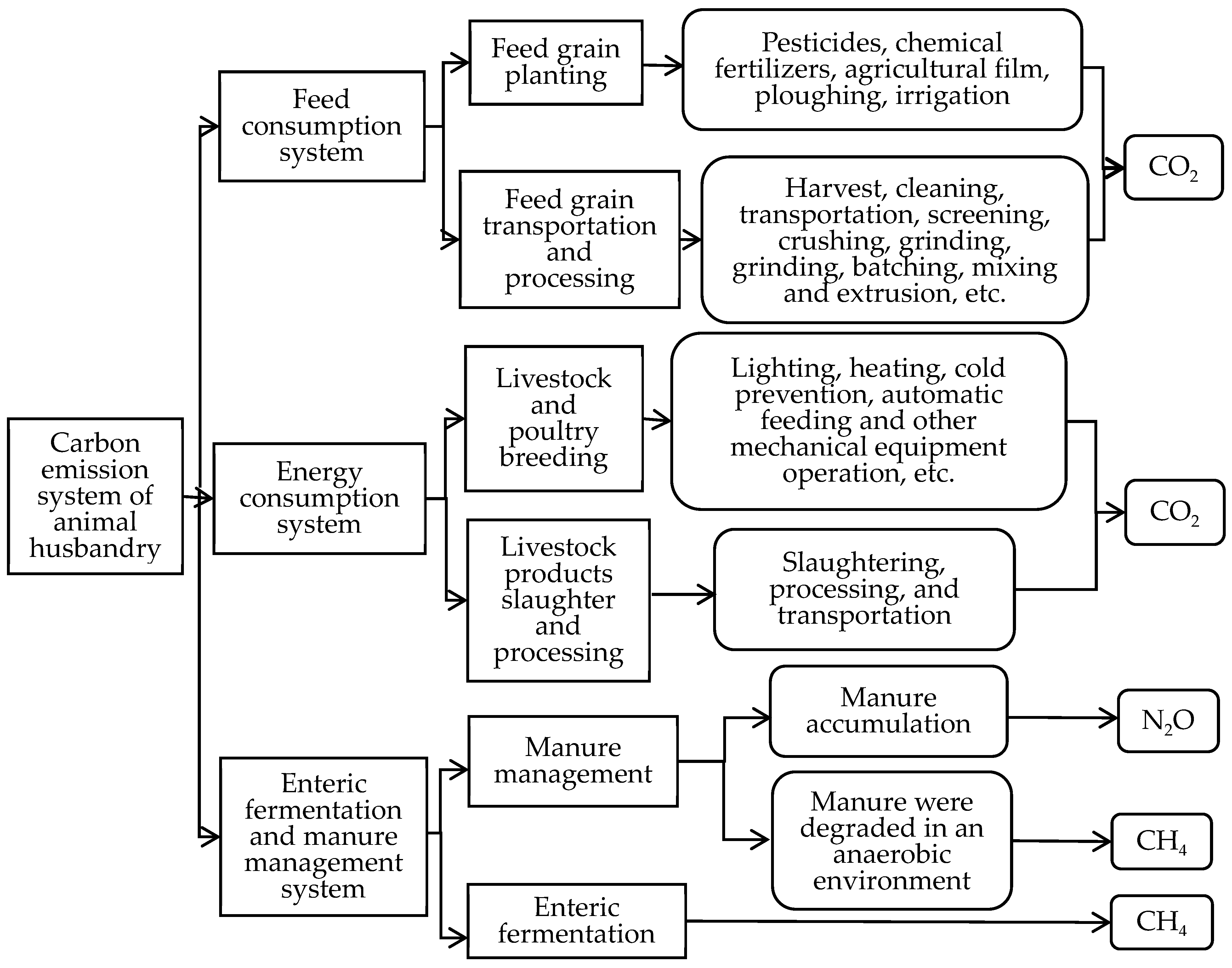
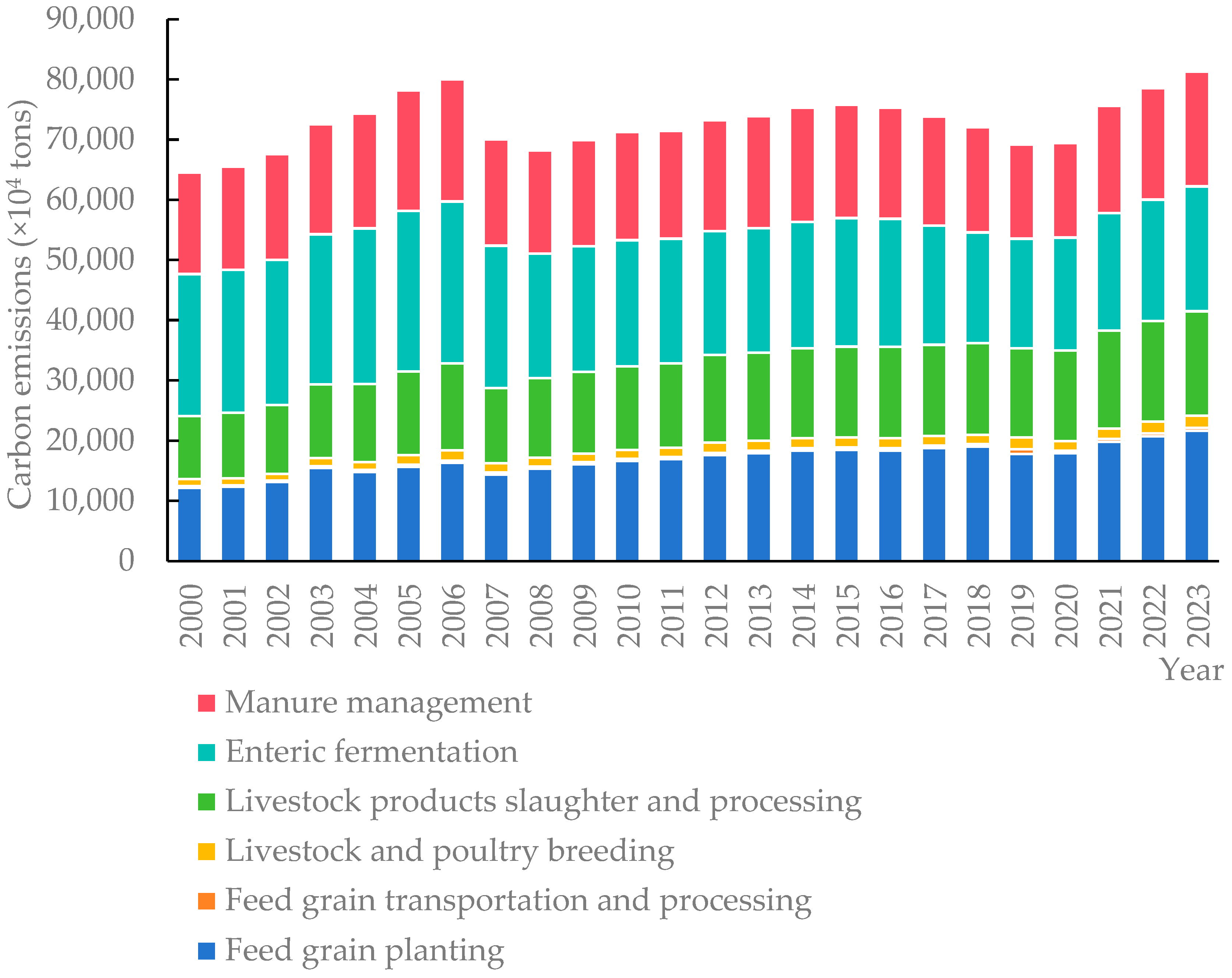


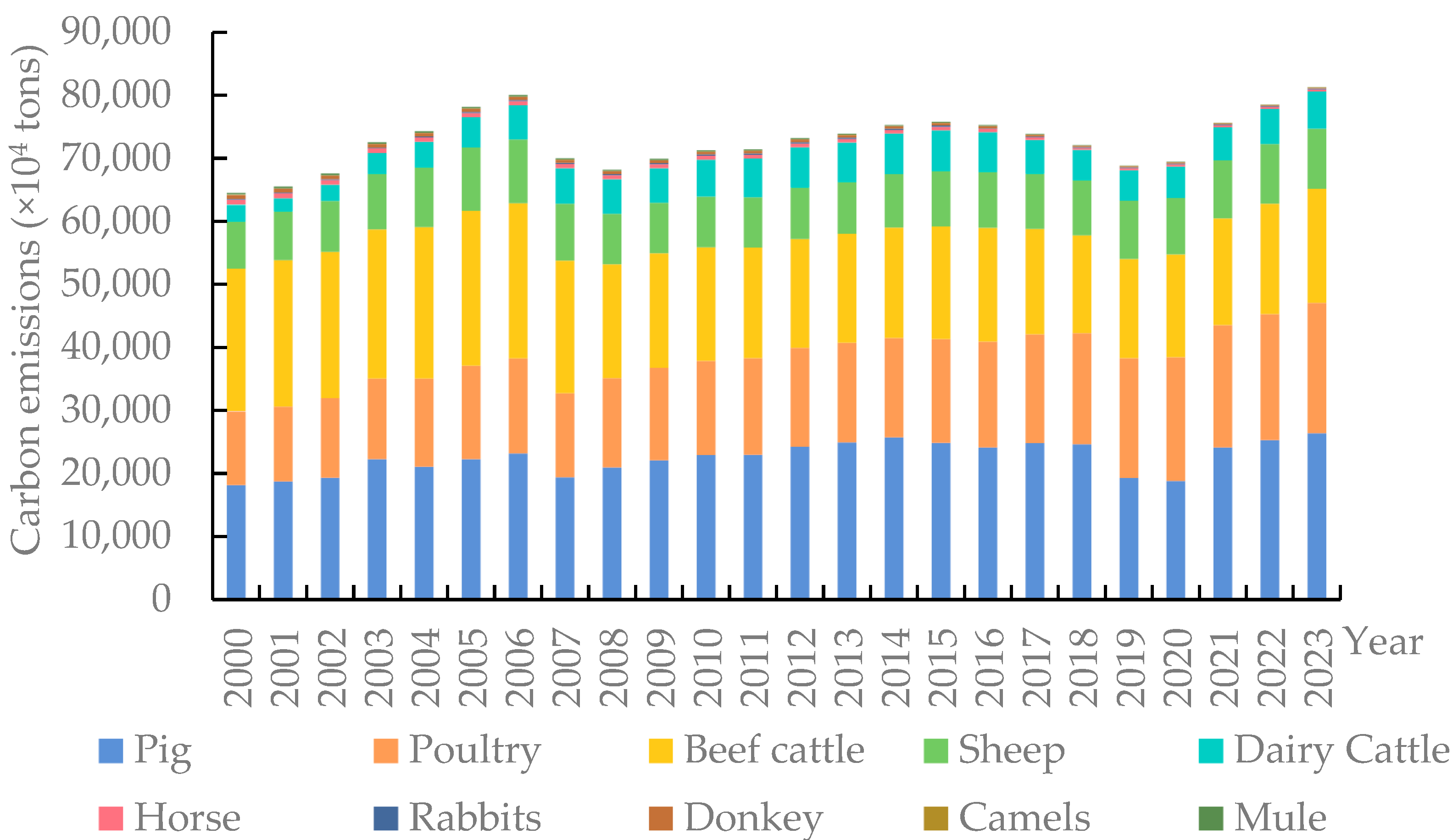
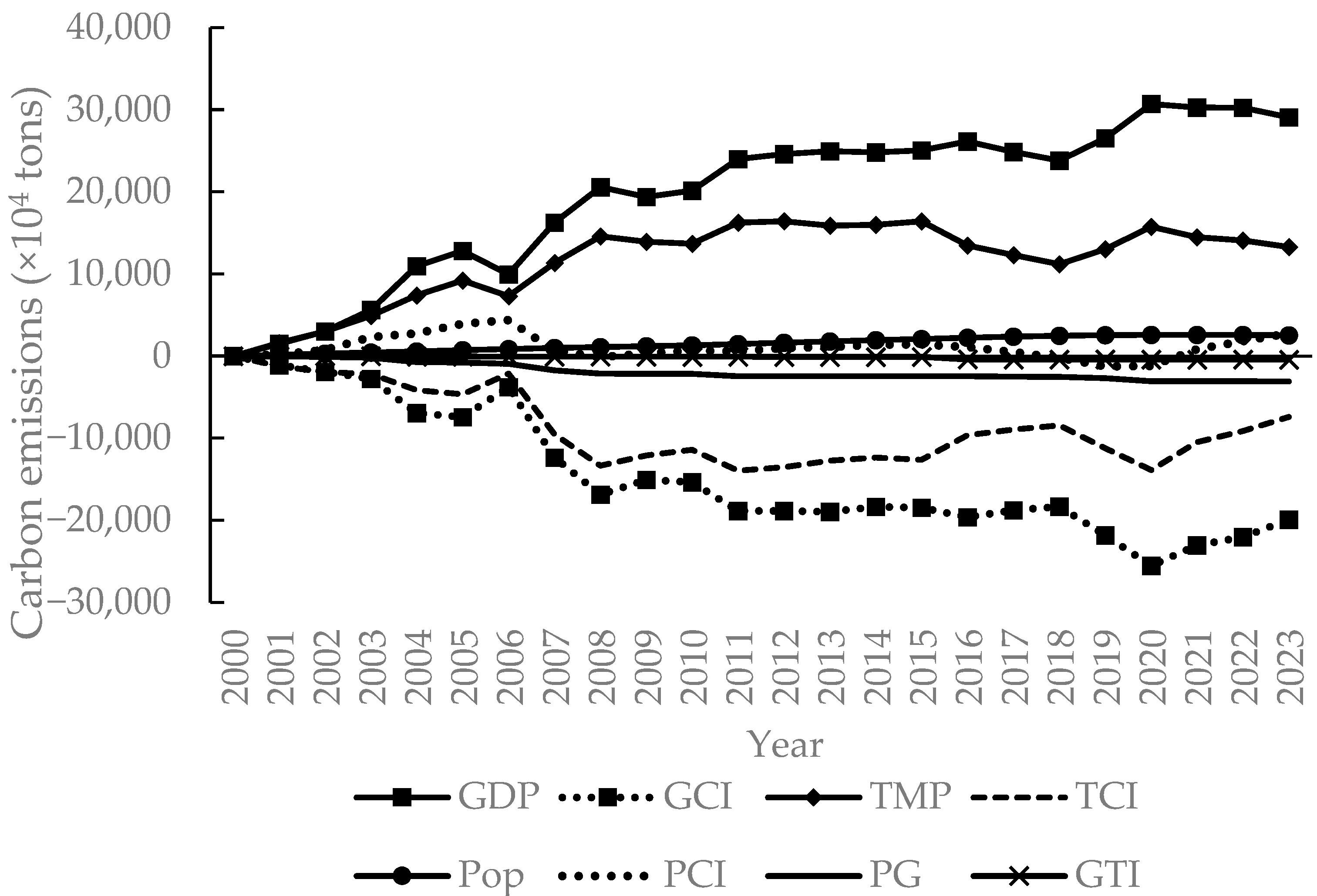
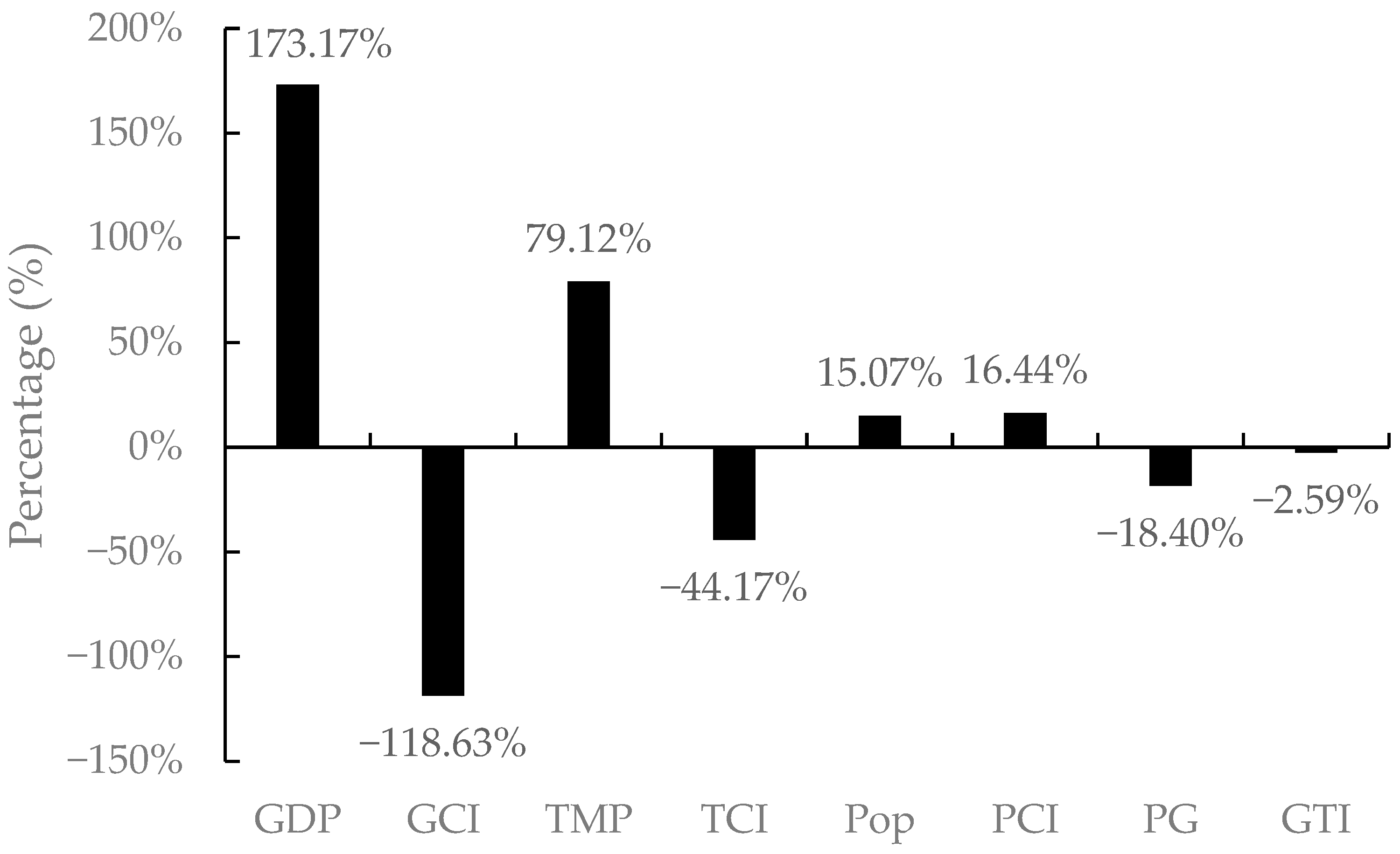
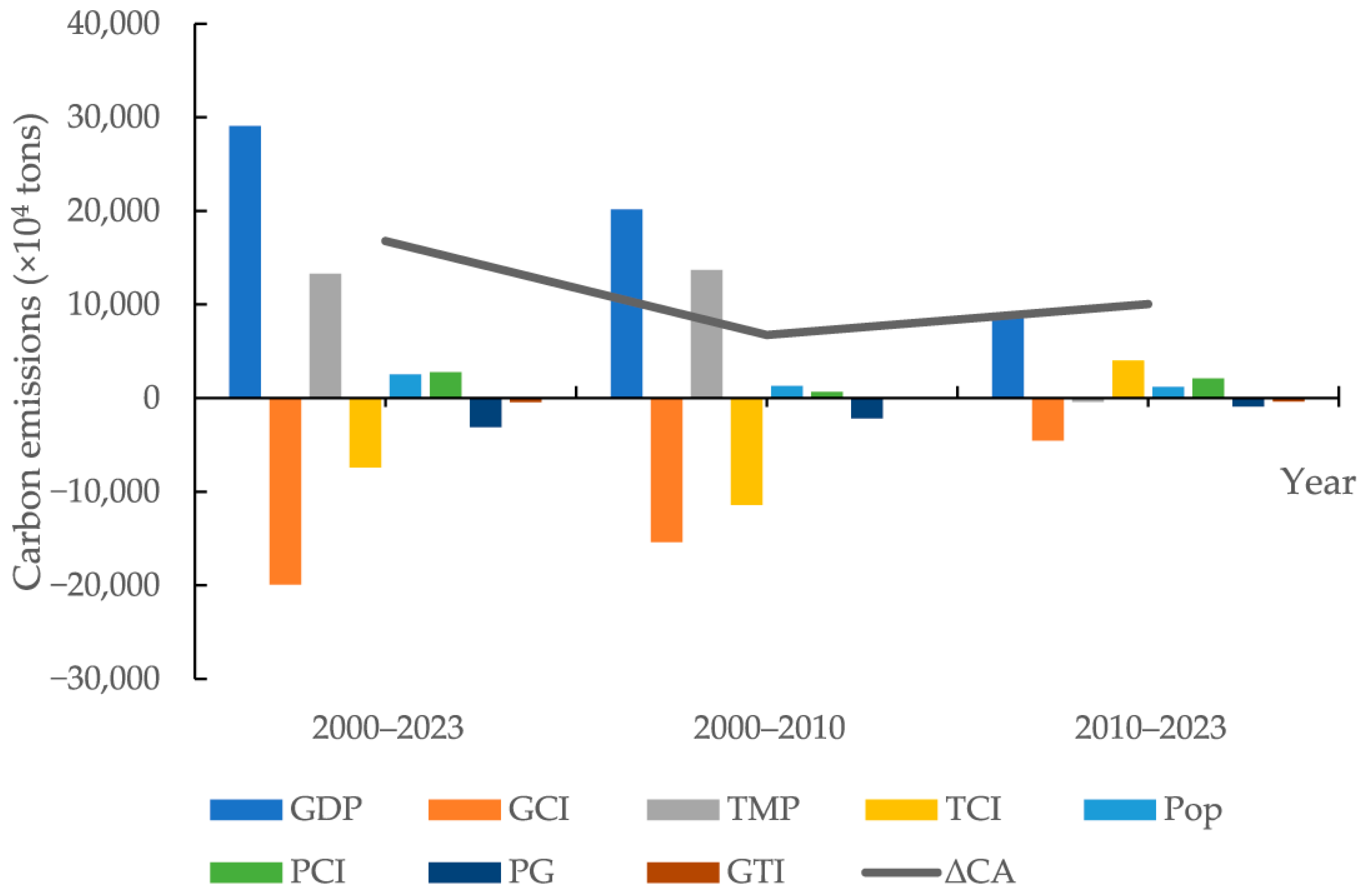
| Category | Enteric Fermentation | Manure Management | Reference Source | |
|---|---|---|---|---|
| CH4 (eci1) | CH4 (eci2) | N2O (eci3) | ||
| Pig | 1 | 3.5 | 0.53 | [3] |
| Dairy Cattle | 68 | 16 | 1 | |
| Beef cattle | 51.4 | 1.50 | 1.37 | [9] |
| Poultry | 0 | 0.02 | 0.02 | [3] |
| Sheep | 5 | 0.16 | 0.33 | |
| Rabbit | 0.254 | 0.08 | 0.02 | |
| Horse | 18 | 1.64 | 1.39 | |
| Donkey | 10 | 0.90 | 1.39 | |
| Mule | 10 | 0.90 | 1.39 | |
| Camel | 46 | 1.92 | 1.39 | |
| System | Sign | Carbon Emission Coefficient | Value | Reference Source |
|---|---|---|---|---|
| Feed grain planting | ej1 | Wheat (t/t) | 1.22 | [8] |
| Corn (t/t) | 1.5 | |||
| Feed grain transportation and processing | ej2 | Wheat (t/t) | 0.0319 | |
| Corn (t/t) | 0.0102 | |||
| Soybean (t/t) | 0.1013 | |||
| Livestock and poultry breeding | pricee | Unit price of electricity (CNY/kWh) | 0.4275 | [9] |
| pricec | Unit price of coal (CNY/t) | 800 | ||
| ef | electricity consumption (tCO2/MWh) | 0.8803 | [24] | |
| ec | coal consumption (t/t) | 1.98 | [9] | |
| Livestock products’ slaughter and processing | MJu | beef (MJ/kg) | 4.37 | [8] |
| pork (MJ/kg) | 3.76 | |||
| Mutton (MJ/kg) | 10.4 | |||
| Poultry (MJ/kg) | 2.59 | |||
| poultry egg (MJ/kg) | 8.16 | |||
| Milk (MJ/kg) | 1.12 | |||
| v | the calorific value of one degree Electricity (MJ) | 3.6 | ||
| Other conversion coefficients | - | 27 | [25] | |
| - | 273 |
Disclaimer/Publisher’s Note: The statements, opinions and data contained in all publications are solely those of the individual author(s) and contributor(s) and not of MDPI and/or the editor(s). MDPI and/or the editor(s) disclaim responsibility for any injury to people or property resulting from any ideas, methods, instructions or products referred to in the content. |
© 2025 by the authors. Licensee MDPI, Basel, Switzerland. This article is an open access article distributed under the terms and conditions of the Creative Commons Attribution (CC BY) license (https://creativecommons.org/licenses/by/4.0/).
Share and Cite
Wang, X.; Xiong, X.; Xin, X. Toward a Sustainable Livestock Sector in China: Evolution Characteristics and Driving Factors of Carbon Emissions from a Life Cycle Perspective. Sustainability 2025, 17, 6537. https://doi.org/10.3390/su17146537
Wang X, Xiong X, Xin X. Toward a Sustainable Livestock Sector in China: Evolution Characteristics and Driving Factors of Carbon Emissions from a Life Cycle Perspective. Sustainability. 2025; 17(14):6537. https://doi.org/10.3390/su17146537
Chicago/Turabian StyleWang, Xiao, Xuezhen Xiong, and Xiangfei Xin. 2025. "Toward a Sustainable Livestock Sector in China: Evolution Characteristics and Driving Factors of Carbon Emissions from a Life Cycle Perspective" Sustainability 17, no. 14: 6537. https://doi.org/10.3390/su17146537
APA StyleWang, X., Xiong, X., & Xin, X. (2025). Toward a Sustainable Livestock Sector in China: Evolution Characteristics and Driving Factors of Carbon Emissions from a Life Cycle Perspective. Sustainability, 17(14), 6537. https://doi.org/10.3390/su17146537





